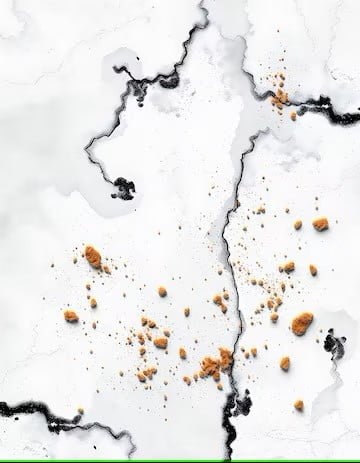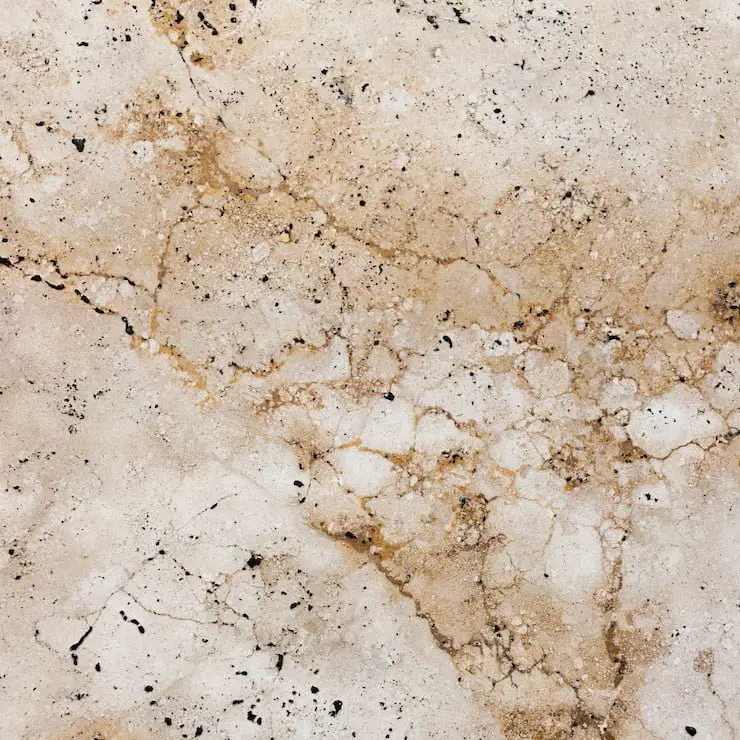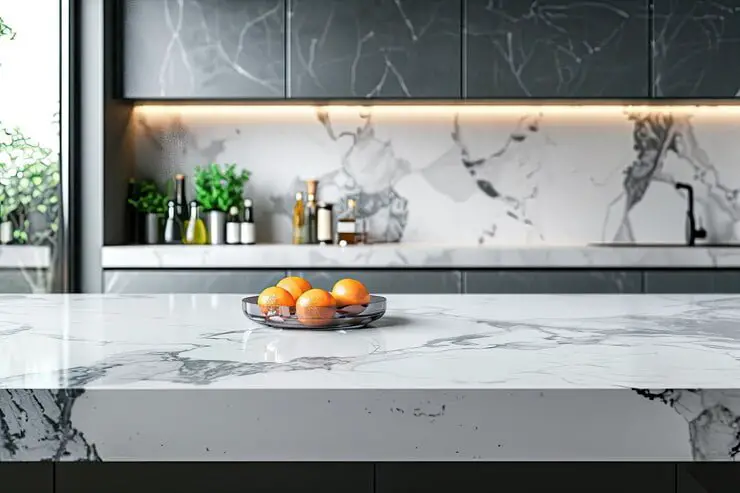Table of Contents
Effective Ways to Get Rid of Water Stains from Marble Surfaces

Introduction
Marble is a timeless, luxurious material that is often used in counter tops, flooring and various home decor elements. However, its beauty comes with a caveat—marble is especially prone to staining from water. Water stains on marble can be unsightly, affecting the beautiful appearance of your surfaces. This guide will provide you with practical ways to effectively remove water stains from marble, helping you restore its natural luster.
Understanding Water Stains on Marble

Water stains on marble occur when water sits on the surface for long periods of time, especially if the water contains minerals or is acidic. Over time, these stains can penetrate the marble’s porous surface, leaving behind dull, cloudy spots. Understanding the nature of these blemishes is the first step towards effectively removing them.
Prevention: The Best Cure
Before diving into stain removal techniques, it’s important to emphasize prevention. Preventing water stains can save you the trouble of dealing with them later. Here are some simple precautions:
- Clean up spills immediately: Marble is porous, so it can easily absorb liquids. Wipe up water spills immediately to prevent them from seeping into the marble.
- Use coasters and trivets: Place coasters under glass and trivets under hot dishes to avoid direct contact with the marble surface.
- SEAL YOUR MARBLE: Applying a high-quality sealant to your marble surfaces can help reduce the risk of water and other liquids staining them.
Method 1: Light water stain removal with a soft cloth and warm water
For light water stains, a gentler approach is often sufficient:
- 1. Wet a soft cloth: Use warm, distilled water to dampen a soft, lint-free cloth. Distilled water is preferred because it lacks minerals that can cause additional stains.
- 2. Gently rub the stain: Rub the stained area in a circular motion, applying light pressure. Avoid using too much water, as too much moisture can cause more stains.
- 3. Dry the area: After rubbing the stain, immediately dry the area with a separate clean, dry cloth. Make sure that no moisture remains on the marble.
Method 2: Removing Moderate Water Stains with Baking Soda
For moderate stains that won’t go away with simple cleaning, baking soda can be an effective, natural solution:
- 1. Make Baking Soda Paste: Mix baking soda with a small amount of water to make a thick paste. The consistency should be like toothpaste.
- 2. Apply the paste to the stain: Spread the paste over the water stain, covering it completely. Let it sit for 24 hours, allowing the baking soda to absorb moisture and minerals from the stain.
- 3. Wipe off the paste: After 24 hours, wipe off the paste with a damp cloth. Rinse the area with distilled water and dry thoroughly.
Method 3: Using Marble Safe Cleaner for Stubborn Stains
If water stains persist, you may need to use a cleaner specifically formulated for marble:
- 1. Choose a marble-safe cleaner: Make sure the cleaner is pH-neutral and safe for use on marble. Avoid acidic or abrasive cleaners that may damage the surface.
- 2. Apply Cleaner: Follow the directions on the cleaner’s label. Typically, you’ll spray the cleaner on the stained area and let it sit for a few minutes.
- 3. Wash and Rinse: Use a soft cloth to clean the area, then rinse with distilled water. Dry the surface immediately to prevent any new stains from forming.
Method 4: Remove Dark Spots with Poultice
For deep or persistent scars, a poultice may be necessary. A poultice is a paste-like substance that removes stains from marble:
- 1. Make the poultice: Mix the poultice powder with distilled water or a marble-safe cleaner to make a thick paste. Powder can be found at most hardware stores or online.
- 2. Apply the poultice: Spread the poultice over the affected area, covering it with plastic wrap. Tape the edges down to seal the poultice in place. Let it sit for 24-48 hours.
- 3. Remove and rinse: After the poultice dries, remove the plastic wrap and scrape off the poultice. Rinse the area with distilled water and dry thoroughly.
How to Get Rid of Water Stains on Marble kitchen Counter tops

Marble kitchen counter tops are a popular choice due to their beautiful appearance and durability. However, these surfaces are particularly prone to water stains, especially in areas around sinks and where liquids are handled frequently. Here’s how you can effectively remove water stains from marble counter tops:
1. Rapid Response to Outbreaks
The kitchen is a high-traffic area, and spills are inevitable. Whenever water or any other liquid spills on your marble counter top, it is very important to clean it up immediately. Use a soft, dry cloth to soak up the liquid to prevent it from seeping into the porous marble.
2. Light water stain removal from wet clothes
If you notice water stains on your counter top, start with an easy cleaning method:
- Wet a soft cloth: Use warm, distilled water and gently wipe the stained area.
- Dry the surface: After wiping, use a clean, dry cloth to absorb any remaining moisture. This method is effective for light, superficial stains.
3. Baking soda for stubborn stains
For more stubborn water stains on kitchen counter tops:
- Apply baking soda paste: Mix baking soda with a small amount of water to make a paste. Spread it on the stain and let it sit for 24 hours.
- Wash and Rinse: After the paste dries, wipe it off with a damp cloth and dry the surface thoroughly. This method helps remove deep stains that can settle into the marble.
4. Using Marble Safe Cleaner
Kitchen counter tops are often exposed to food and liquids that can contribute to staining. For stubborn stains:
- Apply a Marble Safe Cleaner: Use a cleaner specifically designed for marble surfaces. Spray it on the stain, let it sit for a few minutes, then wipe it off with a soft cloth.
- Dry thoroughly: Make sure the area is rinsed with distilled water and dried immediately to prevent any new scarring from forming.
5. Sealing Your Marble Counter top
Given the heavy use of kitchen counter tops, sealing them is an important step in preventing water stains:
Regular Sealing: Apply marble sealer every 6-12 months to protect the surface from moisture and staining. Sealing helps create a barrier that repels water and other liquids, making maintenance easier.
Long Term Care for Kitchen Marble Counter tops
To keep your marble kitchen counter tops looking their best:
- Avoid Harsh Chemicals: Use only pH neutral cleaners that are safe for marble.
- Use cutting boards and trivets: Protect your counter tops from acidic foods and hot utensils by using cutting boards and trivets.
- Clean regularly: Clean your counter tops daily to remove any grease or food particles that can cause stains.
Common Mistakes to Avoid
When cleaning marble, it’s important to avoid common mistakes that can cause more harm than good:
- Using Acidic Cleaners: Acidic substances, including lemon juice and vinegar, can scratch and dull marble surfaces. Always choose pH neutral cleaners.
- Scrubbing with abrasive materials: Avoid using scouring pads, steel wool, or other abrasive materials that can scratch the marble.
- Leaving Spills Unattended: Never leave spills on marble surfaces for long periods of time. Prompt cleaning can prevent long-term damage.
When to Call a Professional
If you’ve tried the above methods and the stain persists, or if your marble surface is significantly damaged, it may be time to consult a professional. Marble restoration experts can assess the damage and offer solutions such as professional polishing, honing or sealing to restore the natural beauty of your marble.
FAQ: How to Get Rid of Water Stains on Marble
1. Can I use vinegar to remove water stains from marble?
Ans:No, you should avoid using vinegar or any other acidic substance on marble. Vinegar can scratch the surface, causing stains and possible damage. Always use a pH neutral cleaner that is safe for marble.
2. How often should I seal my marble counter tops to prevent water stains?
Ans:Marble counter tops are recommended to be sealed every 6-12 months. Sealing helps the surface absorb liquids and prevent staining.
3. What should I do if baking soda does not remove water stains?
Ans: If baking soda doesn’t work, you can try using a poultice, a specific marble cleaner, or consider hiring professional marble restoration services for stubborn or deep stains.
4. Are water stains permanent on marble?
Ans: Most water stains on marble are not permanent and can be removed using proper cleaning methods. However, scars can become more difficult to remove if left untreated for a long time.
5. Can I use household cleaners on marble surfaces?
Ans: No, many household cleaners contain acids or abrasives that can damage marble. Always use cleaners specifically formulated for marble that are pH neutral and non-abrasive.
6. Is it possible to completely prevent water stains on marble?
Ans: Although water stains are difficult to completely prevent, regular maintenance, prompt cleaning of spills, and Periodic sealing can significantly reduce the risk of staining marble surfaces.
7. Can I place hot pans directly on marble counter tops?
Ans: Placing hot pans directly on marble counter tops is not recommended. Heat can cause thermal shock, possibly causing cracks or discoloration. Always use trivets or heat pads.
8. Why does marble get water stains so easily?
Ans: Marble is a porous natural stone, which means it can absorb liquids, including water. When water or other liquids sit on the surface for too long, they can seep into the pores and cause stains.
9. What is the best way to maintain the shine of marble counter tops?
Ans: Regular cleaning with a soft cloth, avoiding harsh chemicals, and periodic sealing are the best ways to maintain the luster of marble counter tops. Additionally, professional polishing every few years can help keep your marble looking pristine.
10. Can I use a steam cleaner on marble surfaces?
Ans: It is generally not recommended to use steam cleaners on marble surfaces as high heat and humidity can cause damage. Stick to gentle cleaning methods to maintain the integrity of your marble.
Conclusion
Marble surfaces, whether in your kitchen, bathroom, or any other part of your home, add a touch of elegance and timeless elegance. However, their porous nature makes them prone to water stains and other types of damage. By understanding the causes of water stains and following the practical methods outlined in this guide, you can effectively restore and maintain the pristine appearance of your marble.
Preventative measures, such as sealing your marble and dealing with immediate wear and tear, are key to maintaining its beauty over time. Regular cleaning with appropriate, marble-safe products and using the right stain removal techniques will help keep your marble surfaces looking as good as new.
When dealing with particularly stubborn stains or significant damage, don’t hesitate to seek professional help to ensure the longevity and aesthetic appeal of your marble. With proper care and attention, your marble surfaces can remain a stunning and durable feature in your home for years to come. Read More

Your article helped me a lot, is there any more related content? Thanks!
Your article helped me a lot, is there any more related content? Thanks!